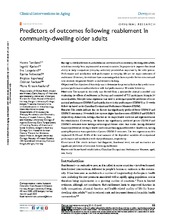| dc.contributor.author | Tuntland, Hanne | en_US |
| dc.contributor.author | Kjeken, Ingvild | en_US |
| dc.contributor.author | Langeland, Eva | en_US |
| dc.contributor.author | Folkestad, Bjarte | en_US |
| dc.contributor.author | Espehaug, Birgitte | en_US |
| dc.contributor.author | Førland, Oddvar | en_US |
| dc.contributor.author | Aaslund, Mona Kristin | en_US |
| dc.date.accessioned | 2017-06-01T13:37:21Z | |
| dc.date.available | 2017-06-01T13:37:21Z | |
| dc.date.issued | 2017 | |
| dc.Published | Tuntland HK, Kjeken I, Langeland E, Folkestad B, Espehaug B, Førland O, Aaslund MK. Predictors of outcomes following reablement in community-dwelling older adults. Clinical Interventions in Aging. 2017;12:55-63 | eng |
| dc.identifier.issn | 1178-1998 | |
| dc.identifier.uri | https://hdl.handle.net/1956/15925 | |
| dc.description.abstract | Background: Reablement is a rehabilitation intervention for community-dwelling older adults, which has recently been implemented in several countries. Its purpose is to improve functional ability in daily occupations (everyday activities) perceived as important by the older person. Performance and satisfaction with performance in everyday life are the major outcomes of reablement. However, the evidence base concerning which factors predict better outcomes and who receives the greatest benefit in reablement is lacking. Objective: The objective of this study was to determine the potential factors that predict occupational performance and satisfaction with that performance at 10 weeks follow-up. Methods: The sample in this study was derived from a nationwide clinical controlled trial evaluating the effects of reablement in Norway and consisted of 712 participants living in 34 municipalities. Multiple linear regression was used to investigate possible predictors of occupational performance (COPM-P) and satisfaction with that performance (COPM-S) at 10 weeks follow-up based on the Canadian Occupational Performance Measure (COPM). Results: The results indicate that the factors that significantly predicted better COPM-P and COPM-S outcomes at 10 weeks follow-up were higher baseline scores of COPM-P and COPM-S respectively, female sex, having a fracture as the major health condition and high motivation for rehabilitation. Conversely, the factors that significantly predicted poorer COPM-P and COPM-S outcomes were having a neurological disease other than stroke, having dizziness/ balance problems as the major health condition and having pain/discomfort. In addition, having anxiety/depression was a predictor of poorer COPM-P outcomes. The two regression models explained 38.3% and 38.8% of the total variance of the dependent variables of occupational performance and satisfaction with that performance, respectively. Conclusion: The results indicate that diagnosis, functional level, sex and motivation are significant predictors of outcomes following reablement. | en_US |
| dc.language.iso | eng | eng |
| dc.publisher | Dove Medical Press | eng |
| dc.relation.ispartof | <a href="http://hdl.handle.net/1956/15926" target="blank">Reablement in home-dwelling older adults</a> | |
| dc.rights | Attribution- NonCommercial CC BY-NC | eng |
| dc.rights.uri | http://creativecommons.org/licenses/by-nc/3.0/ | eng |
| dc.subject | home-based rehabilitation | eng |
| dc.subject | Canadian Occupational Performance Measure | eng |
| dc.subject | aged | eng |
| dc.subject | sex | eng |
| dc.subject | frailty | eng |
| dc.title | Predictors of outcomes following reablement in community-dwelling older adults | en_US |
| dc.type | Peer reviewed | |
| dc.type | Journal article | |
| dc.date.updated | 2017-06-01T13:21:45Z | |
| dc.description.version | publishedVersion | en_US |
| dc.rights.holder | Copyright 2017 Tuntland et al. | |
| dc.identifier.doi | https://doi.org/10.2147/cia.s125762 | |
| dc.identifier.cristin | 1411200 | |

